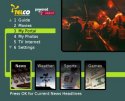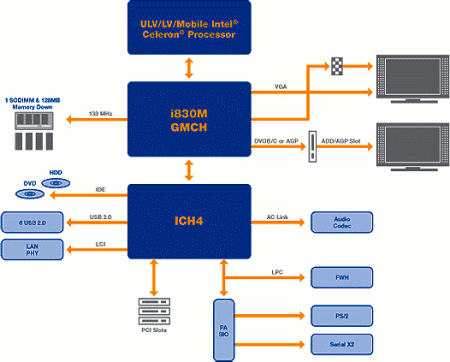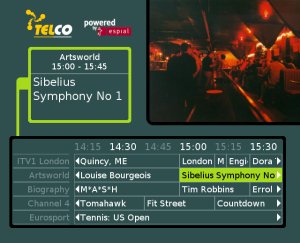IP-STB GUI stack optimized for Intel graphics chipset
Jan 5, 2005 — by Henry Kingman — from the LinuxDevices Archive — views Espial has optimized its Java-based set-top box GUI stack for Intel's 830M4 graphics chipset. Espial's Escape browser and Espresso GUI toolkit target Linux-based IP set-top boxes (IP-STBs) with customizable, internationalizable interfaces based on HTML and Flash, it says.
Espial has optimized its Java-based set-top box GUI stack for Intel's 830M4 graphics chipset. Espial's Escape browser and Espresso GUI toolkit target Linux-based IP set-top boxes (IP-STBs) with customizable, internationalizable interfaces based on HTML and Flash, it says.
Espial's IP-STB stack includes the Escape browser, designed to adapt Web content for display on TV screens, and the Espresso GUI toolkit, designed to help interface designers build interfaces based on HTML, CSS, Flash, and other web technologies. The company says its 830M4-optimized IP-STB stack is appropriate for entry-level boxes with simple interfaces, as well as high-end devices with integrated “triple-play” (voice, data, video) functionality.
According to Espial, the Intel-optimized stack integrates easily with third-party IPTV middleware, and offers easy customization and localization capabilities using open standards such as HTML, CSS, and Flash, as well as through extended bi-directional HTML capabilities announced last month.
Intel's 830M4 chipset is meant for use with the Mobile, Low-Voltage, or Ultra Low-Voltage versions of Intel's Celeron processor. According to Espial, the chipset produces responsive, layerable graphics, because it supports the requirements of the DOM (document object model) Level 1 and 2 for dynamic updating, as well as for color palette graphics planes that are useful for overlays.

Intel's Celeron/830M architecture
(Click to enlarge)
Below are some screenshots provided by Espial of a user interface based on its IP-STB GUI stack. Click any image to enlarge:

Espial's director of marketing for television, Dr. Neale Foster, said, “When they press a button, users want immediate feedback. Espial software running on Intel Architecture provides that kind of responsiveness.”
Intel's GM of strategic planning and marketing for consumer electronics said, “It's all about giving viewers the compelling, game-like experience they expect from their CE device.”
Espial launched the Escape browser in early 2000. It supports x86, MIPS, PowerPC, and ST Micro chips, along with international TV standards that include MHP, OCAP, and ARIB. It uses fit-to-width, font flooring, and other techniques to adapt Web and Flash content — including Flash 6 content — for TV viewing. It requires a Java VM (virtual machine), such as Espial's portability engine. The browser has previously been used in RISC-based Linux STBs, such as i3's Mood box and in multi-architecture reference designs such as Siemens Speedstream.
Intel has previously offered Linux-based reference designs for set-top boxes based on Low-Voltage Celeron processors and its 815 graphics chipset. Low-volume Flash licensing for embedded Linux devices was announced last month by Vibren.
Espial will demonstrate its IP-STB GUI stack on Intel hardware at the Consumer Electronics Show in Las Vegas this week.
This article was originally published on LinuxDevices.com and has been donated to the open source community by QuinStreet Inc. Please visit LinuxToday.com for up-to-date news and articles about Linux and open source.


